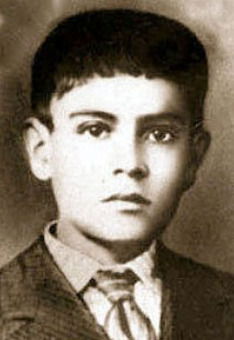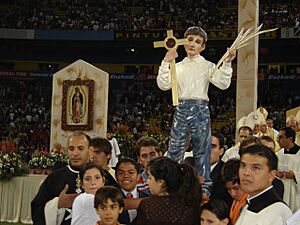José Sánchez del Río facts for kids
Quick facts for kids SaintJosé Luis Sánchez del Río |
|
|---|---|

Photograph of José Sánchez del Río
|
|
| Martyr | |
| Born | March 28, 1913 Sahuayo, Michoacán, Mexico |
| Died | February 10, 1928 (aged 14) Sahuayo, Michoacán, Mexico |
| Venerated in | Catholic Church |
| Beatified | November 20,2005, Guadalajara, Mexico by Cardinal José Saraiva Martins (on the behalf of Pope Benedict XVI) |
| Canonized | October 16, 2016, Saint Peter's Square, Vatican City by Pope Francis |
| Feast | February 10 |
| Attributes |
|
| Patronage |
|
José Luis Sánchez del Río (born March 28, 1913 – died February 10, 1928) was a brave Mexican boy. He was part of a group called the Cristeros. They fought against the Mexican government because it was trying to limit religious freedom. José was killed by government officials because he refused to give up his Catholic faith. People often called him "Joselito."
His story is important because it shows how people stood up for their beliefs. He was recognized by the Catholic Church for his courage. Pope John Paul II declared him "venerable" in 2004. Then, Pope Benedict XVI declared him "blessed" in 2005. Later, Pope Francis approved a miracle linked to José. This led to him becoming a saint on October 16, 2016.
Contents
The Cristero War: A Time of Conflict
The Cristero War was a difficult time in Mexico's history. It began in 1926. The government started to remove special rights from the church. They also took over church properties. This was based on laws in the Mexican Constitution that were against the church.
President Plutarco Elías Calles took office in 1924. He focused on controlling the Roman Catholic Church. This led to the government taking church buildings. They also closed religious schools and convents. Many priests were forced to leave the country or were even killed.
José's Life and His Role in the War
José Luis Sánchez del Río was born on March 28, 1913. His hometown was Sahuayo, Michoacán, Mexico. He went to school there and later in Guadalajara.
When the Cristero War started in 1926, José's older brothers joined the Cristero forces. José wanted to join too, but his mother did not want him to. The general of the rebel forces, Prudencio Mendoza Alcazar, also said no at first.
José insisted that he wanted to join. He said he wanted to give his life for Jesus Christ. He believed this would help him get to Heaven easily. General Mendoza finally agreed. José became the flagbearer for the troop. The Cristeros gave him a nickname, Tarcisius. This was after an early Christian saint who died protecting the Eucharist.
During a big fight on January 25, 1928, a soldier named Mendoza lost his horse. José quickly gave his own horse to Mendoza. This allowed Mendoza to escape safely. José then found cover and kept fighting until he ran out of bullets. Government troops captured him and put him in prison.
José's Burial Place
After his death, José Luis Sánchez del Río was buried. His remains are now in a special place. They are in the Church of Saint James the Apostle in Sahuayo. This is his hometown.
Becoming a Saint: José's Journey
The process for José to become a saint began in 1996. The Congregation for the Causes of Saints approved his cause. This gave him the title of Servant of God. This is the first step on the path to sainthood.
Pope John Paul II approved the findings in 2004. This allowed José to be declared "blessed." He was beatified by Pope Benedict XVI on November 20, 2005, in Mexico.
For someone to become a saint, a miracle is usually needed. A miracle was attributed to José Luis Sánchez del Río. It involved the amazing recovery of a baby in Mexico. Doctors had said the baby had "no hope of survival" between 2008 and 2009.
This miracle was carefully checked. Medical experts and religious leaders approved it. Pope Francis officially approved the miracle on January 21, 2016. He then announced that José would become a saint. José was canonized as a saint of the Roman Catholic Church on October 16, 2016.
José's Lasting Impact
José Luis Sánchez del Río's story continues to inspire people. In 2008, a school was named after him. It is called the "Blessed José Sánchez del Río High School Seminary." It is in Mankato, Minnesota. This school helps young men study to become priests. The students there are known as "The Minor Seminarians."
Another school was also named in his honor. The "St. José Sánchez del Río Catholic School" is in San Antonio, Texas. It was renamed in 2019. The school's mascot is the "Defenders of the Faith." This fits with José's strong belief and courage. The school uses symbols like the rosary and a palm branch. These represent his devotion and faith.
In 2021, this school closed. The campus then became the new St. Jose Sanchez Del Rio Catholic Church parish. The gymnasium was changed into a church. Mass is now celebrated there every day. This new church is growing quickly. It offers religious education and many activities for its members.
See also
- Saints of the Cristero War


